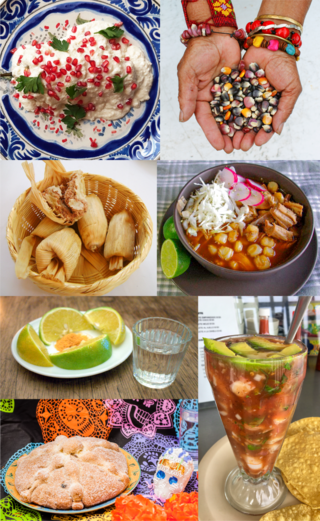
Mexican cuisine consists of the cooking cuisines and traditions of the modern country of Mexico. Its earliest roots lie in Mesoamerican cuisine. Mexican cuisine ingredients and methods begin with the first agricultural communities such as the Olmec and Maya who domesticated maize, created the standard process of nixtamalization, and established their foodways. Successive waves of other Mesoamerican groups brought with them their cooking methods. These included: the Teotihuacanos, Toltec, Huastec, Zapotec, Mixtec, Otomi, Purépecha, Totonac, Mazatec, Mazahua, and Nahua. With the Mexica formation of the multi-ethnic Triple Alliance, culinary foodways became infused.

A submarine sandwich, commonly known as a sub, hoagie, hero, Italian, grinder, wedge, or a spuckie is a type of American cold or hot sandwich made from a cylindrical bread roll split lengthwise and filled with meats, cheeses, vegetables, and condiments.
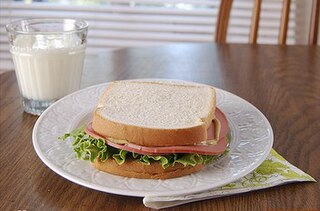
A sandwich is a dish typically consisting of vegetables, sliced cheese or meat, placed on or between slices of bread, or more generally any dish wherein bread serves as a container or wrapper for another food type. The sandwich began as a portable, convenient finger food in the Western world, though over time it has become prevalent worldwide.

Chorizo is a type of pork sausage originating from the Iberian Peninsula. It is made in many national and regional varieties in several countries on different continents. Some of these varieties are quite different from each other, occasionally leading to confusion or disagreements over the names and identities of the products in question.

Torta is a culinary term that can, depending on the cuisine, refer to cakes, pies, flatbreads, sandwiches, or omelettes.

A wrap is a culinary dish made with a soft flatbread rolled around a filling.

A teacake in England is generally a light yeast-based sweet bun containing dried fruit, typically served toasted and buttered. In the U.S. teacakes can be cookies or small cakes. In Sweden, they are soft, round, flat wheat breads made with milk and a little sugar, and used to make buttered ham or cheese sandwiches. In India and Australia, a teacake is more like a butter cake. Tea refers to the popular beverage to which these baked goods are an accompaniment.
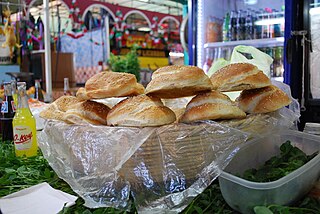
The cemita is a sandwich originally from Puebla, Mexico. Also known as cemita poblana, it derives from the city of Puebla. The word refers to the sandwich as well as to the roll it is typically served on, a bread roll covered with sesame seeds. Additionally, the ingredients usually are restricted to sliced avocado, meat, Oaxaca cheese, onions, the herb pápalo and chipotle adobado, or jalapeño.

A chicken sandwich is a sandwich that typically consists of boneless, skinless chicken breast or thigh, served between slices of bread. Variations on the "chicken sandwich" include chicken on a bun, chicken on a Kaiser, hot chicken, or chicken salad sandwich.
A pistolette is either of two bread-based dishes in Louisiana cuisine. One is a fried bread roll, that can also be stuffed, in the Cajun areas around Lafayette and Lake Charles. The other is a type of submarine shaped bread about half the size of a baguette that is popular in New Orleans for Vietnamese bánh mì and other sandwiches. In France and Belgium, the word pistolet refers to a round roll.

Sponge cake is a light cake made with eggs, flour and sugar, sometimes leavened with baking powder. Some sponge cakes do not contain egg yolks, like angel food cake, but most of them do. Sponge cakes, leavened with beaten eggs, originated during the Renaissance, possibly in Spain. The sponge cake is thought to be one of the first non-yeasted cakes, and the earliest attested sponge cake recipe in English is found in a book by the English poet Gervase Markham, The English Huswife, Containing the Inward and Outward Virtues Which Ought to Be in a Complete Woman (1615). Still, the cake was much more like a cracker: thin and crispy. Sponge cakes became the cake recognised today when bakers started using beaten eggs as a rising agent in the mid-18th century. The Victorian creation of baking powder by English food manufacturer Alfred Bird in 1843 allowed the addition of butter to the traditional sponge recipe, resulting in the creation of the Victoria sponge. Cakes are available in many flavours and have many recipes as well. Sponge cakes have become snack cakes via the Twinkie.

Sandwich bread is bread that is prepared specifically to be used for the preparation of sandwiches. Sandwich breads are produced in many varieties, such as white, whole wheat, sourdough, rye, multigrain and others.

A fish sandwich is, most generally, any kind of sandwich made with fish. The term is frequently used to describe food made with breaded, fried fish, which are commonly found in fast food venues.
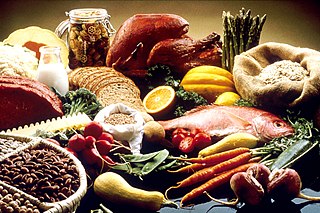
This is a categorically organized list of foods. Food is any substance consumed to provide nutritional support for the body. It is produced either by plants, animals, or fungi, and contains essential nutrients, such as carbohydrates, fats, proteins, vitamins, and minerals. The substance is ingested by an organism and assimilated by the organism's cells in an effort to produce energy, maintain life, or stimulate growth.

A hoagie roll or hero roll is a type of long roll used to prepare hoagie sandwiches. Hoagie rolls are sometimes toasted before being used to prepare a sandwich.
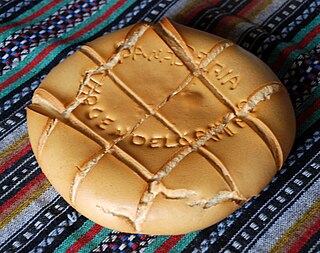
Bread in Spain has an ancient tradition with various preparations in each region. Wheat is by far the most cultivated cereal, as it withstands the dry climate of the interior of the country. Since time immemorial, bread is a staple food that accompanies all daily meals, all year round. In fact, the Iberian Peninsula is one of the European regions with the greatest diversity of breads. The Spanish gourmet José Carlos Capel estimated a total of 315 varieties of bread in Spain, although the barra is, by far, the most consumed variety of bread (75%). In addition to food, bread in Spain has a historical, cultural, religious and mythological function.

In Spain, telera is a typical bread from the area of Córdoba. Includes ~W130 wheat flour, sourdough, water, salt and yeast. Its peculiar shape, which resembles a montera, is the result of the deep marks (greña) that are made, generally two, and diagonally along the piece. Being a candeal bread, it is quite durable, but when it gets hard, it is typically used to make salmorejo from Córdoba.




























